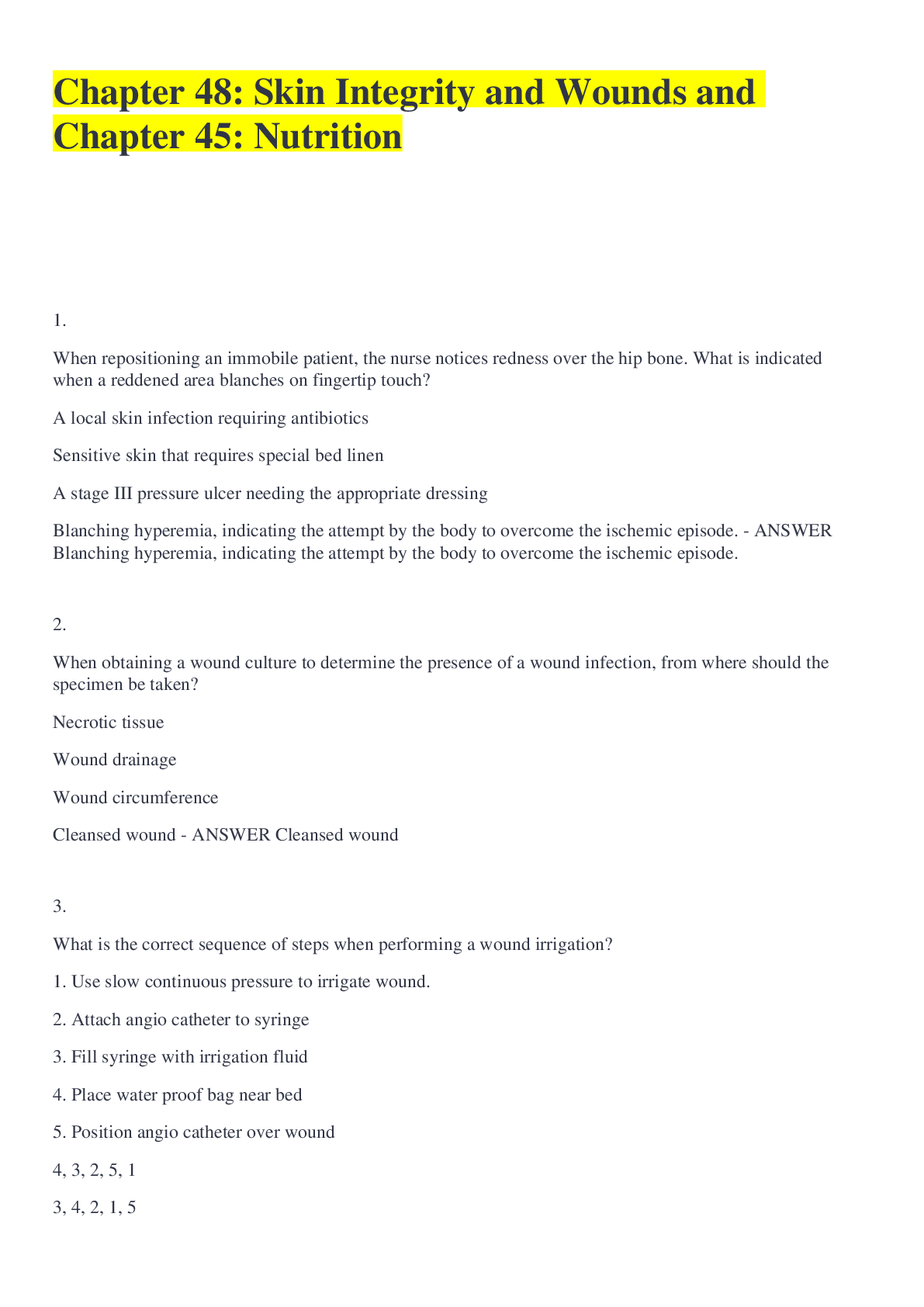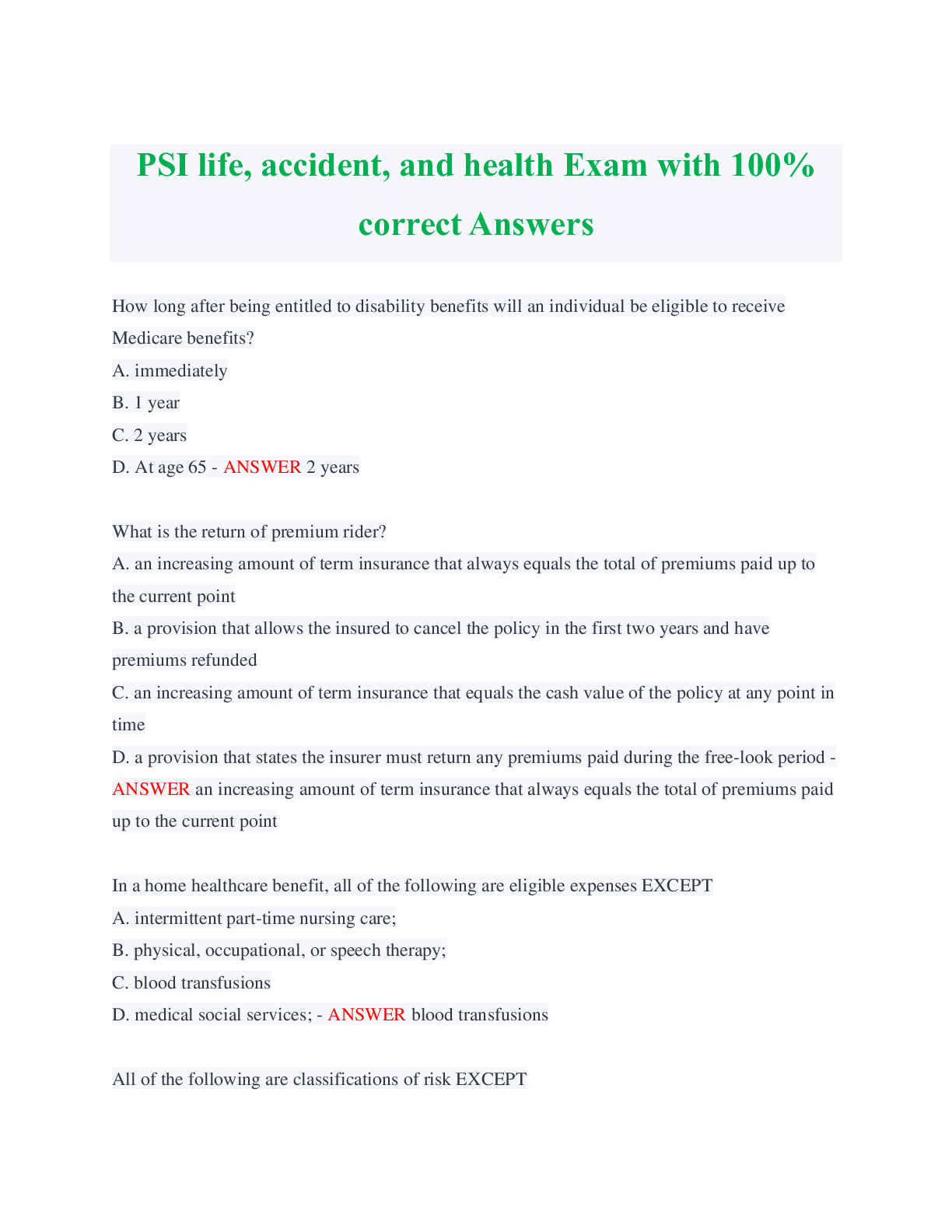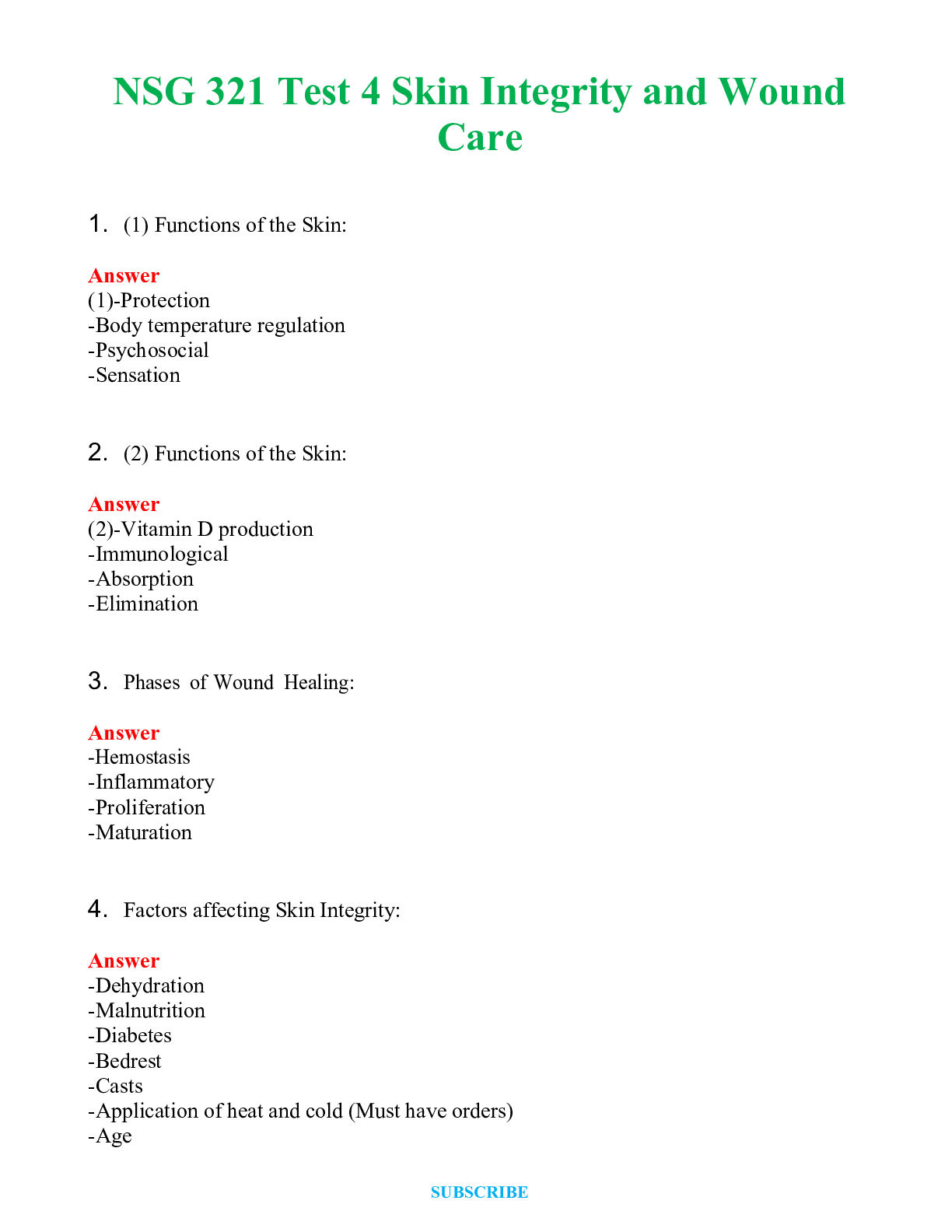Health Care > EXAM > Chapter 48: Skin Integrity and Wounds and Chapter 45: Nutrition (All)
Chapter 48: Skin Integrity and Wounds and Chapter 45: Nutrition
Document Content and Description Below
1. When repositioning an immobile patient, the nurse notices redness over the hip bone. What is indicated when a reddened area blanches on fingertip touch? A local skin infection requiring antibiot... ics Sensitive skin that requires special bed linen A stage III pressure ulcer needing the appropriate dressing Blanching hyperemia, indicating the attempt by the body to overcome the ischemic episode. - ANSWER Blanching hyperemia, indicating the attempt by the body to overcome the ischemic episode. 2. When obtaining a wound culture to determine the presence of a wound infection, from where should the specimen be taken? Necrotic tissue Wound drainage Wound circumference Cleansed wound - ANSWER Cleansed wound 3. What is the correct sequence of steps when performing a wound irrigation? 1. Use slow continuous pressure to irrigate wound. 2. Attach angio catheter to syringe 3. Fill syringe with irrigation fluid 4. Place water proof bag near bed 5. Position angio catheter over wound 4, 3, 2, 5, 1 3, 4, 2, 1, 5 4, 2, 3, 5, 1 2, 3, 4, 5, 1 - ANSWER 4, 3, 2, 5, 1 4. For a patient who has a muscle sprain, localized hemorrhage, or hematoma, which wound care product helps prevent edema formation, control bleeding, and anesthetize the body part? Binder Ice bag Elastic bandage Absorptive dressing - ANSWER Ice bag 5. Which of the following describes a hydrocolloid dressing? A seaweed derivative that is highly absorptive Premoistened gauze placed over a granulating wound A debriding enzyme that is used to remove necrotic tissue A dressing that forms a gel that interacts with the wound surface - ANSWER A dressing that forms a gel that interacts with the wound surface 6. What is the removal of devitalized tissue from a wound called? Debridement Pressure reduction Negative pressure wound therapy Sanitization - ANSWER Debridement 7. What does the Braden Scale evaluate? Skin integrity at bony prominences, including any wounds Risk factors that place the patient at risk for skin breakdown The amount of repositioning that the patient can tolerate The factors that place the patient at risk for poor healing - ANSWER Risk factors that place the patient at risk for skin breakdown 8. On assessing your patient's sacral pressure ulcer, you note that the tissue over the sacrum is dark, hard, and adherent to the wound edge. What is the correct category/stage for this patient's pressure ulcer? Category/Stage II Category/Stage IV Unstageable Suspected deep tissue damage - ANSWER Unstageable Nonblanchable redness of intact skin. Discoloration, warmth, edema, or pain may also be present. - ANSWER Category Stage 1 Full thickness skin loss, subcutaneous fat may be visible. May include undermining - ANSWER Category Stage III Full thickness tissue loss, muscle and bone visible. May include undermining. - ANSWER Category Stage IV Partial thickness skin loss or intact blister with serosanginous fluid. - ANSWER Category Stage II 10. After surgery the patient with a closed abdominal wound reports a sudden "pop" after coughing. When the nurse examines the surgical wound site, the sutures are open, and pieces of small bowel are noted at the bottom of the now-opened wound. Which are the priority nursing interventions? (Select all that apply.) Notify the surgeon Allow the area to be exposed to air until all drainage has stopped Place several cold packs over the area, protecting the skin around the wound Cover the area with sterile, saline-soaked towels and immediately. Cover the area with sterile gauze and apply an abdominal binder - ANSWER Notify the surgeon Cover the area with sterile, saline-soaked towels and immediately. 11. Which skin care measures are used to manage a patient who is experiencing fecal and/or urinary incontinence? (Select all that apply.) Frequent position changes. Keeping the buttocks exposed to air at all times Using a large absorbent diaper, changing when saturated Using an incontinence cleaner Frequent cleaning, applying an ointment, and covering the areas with a thick absorbent towel Applying a moisture barrier ointment - ANSWER Frequent position changes. Using an incontinence cleaner Applying a moisture barrier ointment 12. Which of the following is an indication for a binder to be placed around a surgical patient with a new abdominal wound? (Select all that apply.) Collection of wound drainage Provides support to abdominal tissues when coughing or walking Reduction of abdominal swelling Reduction of stress on the abdominal incision Stimulation of peristalsis (return of bowel function) from direct pressure - ANSWER Provides support to abdominal tissues when coughing or walking Reduction of stress on the abdominal incision 13. When is an application of a warm compress to an ankle muscle sprain indicated? (Select all that apply.) To relieve edema To reduce shivering To improve blood flow to an injured part To protect bony prominences from pressure ulcers To immobilize area - ANSWER To relieve edema To improve blood flow to an injured part 14. Which of the following are measures to reduce tissue damage from shear? (Select all that apply.) Use a transfer device, e.g. transfer board Have head of bed elevated when transferring patient Have head of bed flat when re positioning patients Raise head of bed 60 degrees when patient positioned supine Raise head of bed 30 degrees when patient positioned supine - ANSWER Use a transfer device, e.g. transfer board Have head of bed flat when re positioning patients Raise head of bed 30 degrees when patient positioned supine 1. The nurse evaluates which laboratory values to assess a patient's potential for wound healing? Fluid status Potassium Lipids Nitrogen balance - ANSWER Nitrogen balance 2. The nurse is caring for a patient with dysphagia and is feeding her a pureed chicken diet when she begins to choke. What is the priority nursing intervention? Suction her mouth and throat Turn her on their side Put on oxygen at 2-L nasal cannula Stop feeding her and place on NPO - ANSWER Suction her mouth and throat 3. A patient who is receiving parenteral nutrition (PN) through a central venous catheter (CVC) has an air embolus. What would the nurse do first? Have the patient perform a Valsalva procedure Clamp the intravenous (IV) tubing to prevent more air from entering the line Have the patient take a deep breath and hold it Notify the health care provider immediately - ANSWER Have the patient perform a Valsalva procedure 4. A patient is receiving both parenteral (PN) and enteral nutrition (EN). When would the nurse collaborate with the health care provider and request discontinuing parenteral nutrition? When 25% of the patient's nutritional needs are met by the tube feedings When bowel sounds return When central line has been in for 10 days When 75% of the patient's nutritional needs are met by the tube feedings - ANSWER When 75% of the patient's nutritional needs are met by the tube feedings 5. The nurse is inserting a small-bore nasoenteric tube before starting enteral feedings. What is the correct order of steps to perform this procedure? 1. Place patient in high-Fowler's position. 2. Have patient flex head toward chest. 3. Assess patient's gag reflex. 4. Determine length of the tube to be inserted. 5. Obtain radiological confirmation of tube placement. 6. Check pH of gastric aspirate for verifying placement. 7. Identify patient with two identifiers. 7, 1, 3, 4, 2, 5, 6 1, 3, 4, 7, 2, 6, 5 7, 1, 3, 2, 4, 6, 5 1, 7, 3, 2, 4, 5, 6 - ANSWER 7, 1, 3, 4, 2, 5, 6 6. A patient's gastric residual volume was 250 mL at 0800 and 350 mL at 1200. What is the appropriate nursing action? Assess bowel sounds Raise the head of the bed to at least 45 degrees Position the patient on his or her right side to promote stomach emptying Do not reinstall aspirate and hold the feeding until you talk to the primary care provider - ANSWER Do not reinstall aspirate and hold the feeding until you talk to the primary care provider 7. The patient's blood glucose level is 330 mg/dL. What is the priority nursing intervention? Recheck by performing another blood glucose test. Call the primary health care provider. Check the medical record to see if there is a medication order for abnormal glucose levels. Monitor and recheck in 2 hours. - ANSWER Check the medical record to see if there is a medication order for abnormal glucose levels. 8. Which statement made by a patient of a 2-month-old infant requires further education? I'll continue to use formula for the baby until he is a least a year old. I'll make sure that I purchase iron-fortified formula. I'll start feeding the baby cereal at 4 months. I'm going to alternate formula with whole milk starting next month. - ANSWER I'm going to alternate formula with whole milk starting next month. 9. The nurse sees the nursing assistive personnel (NAP) perform the following intervention for a patient receiving continuous enteral feedings. Which action would require immediate attention? Fastening tube to the gown with new tape Placing patient supine while giving a bath Hanging a new container of enteral feeding Ambulating patient with enteral feedings still infusing - ANSWER Placing patient supine while giving a bath 10. A patient is receiving total parenteral nutrition (TPN). What is the primary intervention the nurse should follow to prevent a central line infection? Institute isolation precautions Clean the central line port through which the TPN is infusing with alcohol Change the TPN tubing every 24 hours Monitor glucose levels to watch and assess for glucose intolerance - ANSWER Clean the central line port through which the TPN is infusing with alcohol 11. The nurse is caring for a patient with pneumonia who has severe malnutrition. The nurse recognizes that, because of the nutritional status, the patient is at increased risk for: (Select all that apply.) Heart disease. Sepsis. Pleural effusion. Cardiac arrhythmias. Diarrhea. - ANSWER Sepsis. Pleural effusion. Cardiac arrhythmias. 12. The nurse is educating the patient and his family about the parenteral nutrition. Which aspect related to this form of nutrition would be appropriate to include? (Select all that apply.) The purpose of the fat emulsion in parenteral nutrition is to prevent a deficiency in essential fatty acids. We can give you parenteral nutrition through your peripheral intravenous line to prevent further infection. The fat emulsion will help control hyperglycemia during periods of stress. The parenteral nutrition will help your wounds heal. Since we just started the parenteral nutrition, we will only infuse it at 50% of your daily needs for the next 6 hours. - ANSWER The purpose of the fat emulsion in parenteral nutrition is to prevent a deficiency in essential fatty acids. The fat emulsion will help control hyperglycemia during perio [Show More]
Last updated: 2 years ago
Preview 1 out of 28 pages

Buy this document to get the full access instantly
Instant Download Access after purchase
Buy NowInstant download
We Accept:

Reviews( 0 )
$7.00
Can't find what you want? Try our AI powered Search
Document information
Connected school, study & course
About the document
Uploaded On
Oct 10, 2022
Number of pages
28
Written in
Additional information
This document has been written for:
Uploaded
Oct 10, 2022
Downloads
0
Views
59














 (1).png)



